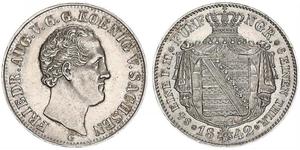1 Thaler Kingdom of Saxony (1806 - 1918) Silver
1830, Kingdom of Saxony, Anthony. Large Silver Convention Thaler Coin.
Mint Year: 1830
Mint Place: Dresden
Denomination: Thaler (Convention)
Mint Master: Johann Gotthelf Studer
Reference: Davenport 867, KM-1120.
Diameter: 37mm
Material: Silver
Weight: 27.9gm
Obverse: Head of Anthony as King of Saxony right.
Legend: ANTON V.G.G. KOENIG VON SACHSEN
Reverse: Crowned shield of Saxony inside wreath. Mint master´s initial (S) below.
Legend: ZEHN EINE FEINE MARK 1830
Anthony (b. Dresden, 27 December 1755 – d. Dresden, 6 June 1836), also known by his German name Anton (full name: Anton Clemens Theodor Maria Joseph Johann Evangelista Johann Nepomuk Franz Xavier Aloys Januar), was a King of Saxony (1827-1836) from the House of Wettin. He became known as Anton der Gütige, (en: “Anthony the Kind”).
He was the fifth but third surviving son of Frederick Christian, Elector of Saxony, and Maria Antonia Walpurgis of Bavaria.
With few chances to take part in the politics of the Electorate of Saxony or receive any land from his older brother Frederick Augustus III, Anton lived under the shadows. No Elector of Saxony after Johann Georg I gave appananges to his younger sons.
During the first years of the reign of his older brother as Elector, Anton was the third in line, preceded only by his older brother Karl. The death of Karl (8 September 1781) make him the next in line to the Electorate as Crown Prince (de: Kronprinz); this was because all the pregnancies of the Electress Amalie, except for one daughter, ended in a stillbirth.
In Turin on 29 September 1781 (by proxy) and again in Dresden on 24 October 1781 (in person), Anton married firstly with the Princess Caroline of Savoy (Maria Carolina Antonietta Adelaida), daughter of the King Victor Amadeus III of Sardinia. Caroline died after only one year of marriage, on 28 December 1782. They had no children.
In Florence on 8 September 1787 (by proxy) and again in Dresden on 18 October 1787 (in person), Anton married a second time with the Archduchess Maria Theresia of Austria (Maria Theresia Josephe Charlotte Johanna), daughter of the Grand Duke Leopold I of Tuscany, later Emperor Leopold II. Mozart’s opera Don Giovanni was originally intended to be performed in honor of Anton and his wife for a visit to Prague on October 14, 1787, as they traveled between Dresden and Vienna, and librettos were printed with dedication to them. The premiere could not be arranged in time, however, so the opera The Marriage of Figaro was substituted on the express orders of the bride’s uncle, Holy Roman Emperor Joseph II. The choice of The Marriage of Figaro was considered improper for a new bride by many observers, and the couple left the opera theater early without seeing the entire work performed. Mozart complained bitterly of the intrigues surrounding this incident in a letter to his friend Gottfried von Jacquin that was written in stages between October 15 and October 25, 1787.
Anton succeeded his brother Frederick August I as King of Saxony when he died, on 5 May 1827. The 71-years-old new King was completely inexperienced in government, thus he had no intention of initiating profound changes in foreign or domestic policy.
Prussian diplomats discussed granting the Prussian Rhineland (predominantly Catholic) to Anton (a Catholic) in exchange for Lutheran Saxony in 1827, but nothing came of these talks.
After the July Revolution of 1830 in France, disturbances in Saxony began in autumn. These were directed primarily against the old Constitution. Therefore, on 13 September the cabinet dismissed Count Detlev von Einsiedel, followed by Bernhard von Lindenau. Because the people wished a younger regent, Anton agreed to appoint his nephew Frederick Augustus Prince Co-Regent (de: Prinz-Mitregenten). As another consequence of the disturbances, a new constitution was accepted in 1831 which came into effect on 4 September of that year. With it Saxony became a Constitutional monarchy. The constitution was more conservative than other constitutions existing at this time in the German Union. The King kept his exclusive sovereignty but was bound by the Government Business to cooperate with the Ministers and the decisions of both Chambers of the States (de: Kammern der Ständeversammlung) meeting. The entry of Saxony into the Zollverein in 1833 let trade, industry and traffic blossom farther.
Without surviving male issue, Anton was succeeded as King by his nephew, Frederick Augustus II.
View all coins in the group
(900 X 451pixels, file size: ~129K)
Posted by: anonymous 2015-11-17
Sachsen-Albertinische Linie, Anton Taler 1832 S. Jaeger 60, Thun 309, AKS 66, Kahnt 435. Kl. Randfehler, winziger Kratzer, sehr schön
(900 X 453pixels, file size: ~127K)
Posted by: anonymous 2015-11-21
Sachsen-Albertinische LinieTaler 1829 S. Jaeger 60, Thun 309, AKS 66. Winz. Randfehler, winz. Kratzer, sehr schön
(900 X 452pixels, file size: ~118K)
Posted by: anonymous 2015-11-16
Sachsen-Albertinische Linie, Anton Taler 1830 S. Jaeger 60, Thun 309, AKS 66, Kahnt 435, K.M. 1120. Schöne Patina. Vorzüglich +
(900 X 447pixels, file size: ~140K)
Posted by: anonymous 2015-09-02
DEUTSCHLAND Sachsen, Herzogtum, ab 1547 Kurfürstentum, ab 1806 Königreich Albertiner Anton, 1827-1836. Konventionstaler 1832, Dresden. 27.88 g. Kahnt 435. Thun 309. Dav. 867. Sehr schön-vorzüglich.
(900 X 446pixels, file size: ~143K)
Posted by: anonymous 2015-09-02
DEUTSCHLAND Sachsen, Herzogtum, ab 1547 Kurfürstentum, ab 1806 Königreich Albertiner Anton, 1827-1836. Konventionstaler 1831, Dresden. 27.98 g. Kahnt 435. Thun 309. Dav. 867. Kl. Kr. Vorzüglich.
(900 X 452pixels, file size: ~125K)
Posted by: anonymous 2015-11-21
Sachsen-Albertinische LinieTaler 1834 G. Jaeger 60, Thun 309 G, AKS 66, Kahnt 435. Randfehler, sehr schön
|
1 Real Republic of Guatemala (1838 - ) Silver
group has 3 coins / 1 prices
⇑

-500-250-b4kKqUpYwpcAAAFgIrc8PlgT.jpg)
-300-150-QLEKbzbiqScAAAFRkJFauxOl.jpg)
-300-150-3lkKbzbicJgAAAFRsQFauyjr.jpg)
-300-150-H_cKbzbi8owAAAFRqPdauw5b.jpg)
-300-150-HvQKbzbitlIAAAFPbdSA8I8R.jpg)
-300-150-Kx4KbzbiRdAAAAFPSyyA8Itu.jpg)
-300-150-G8oKbzbi418AAAFRznxauygD.jpg)






-300-150-84_BwcI0zyMAAAEq6fJDRaZN.jpg)







